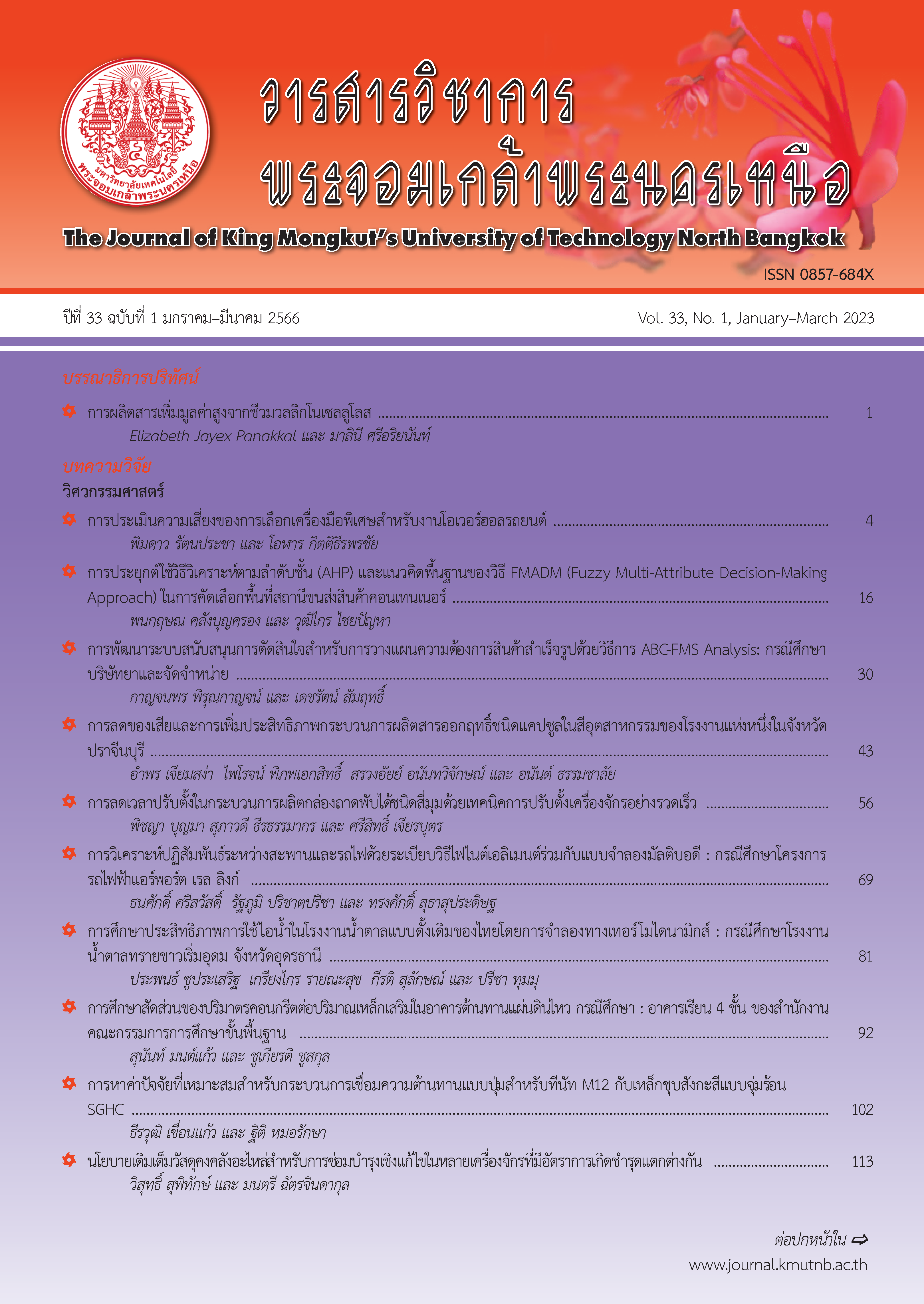การประเมินความเสี่ยงของการเลือกเครื่องมือพิเศษสำหรับงานโอเวอร์ฮอลรถยนต์
Main Article Content
บทคัดย่อ
ด้วยสภาวการณ์แข่งขันสูง บริษัทยานยนต์ในประเทศไทยได้เสนอทางเลือกหลากหลายเพื่อความพึงพอใจของผู้บริโภครวมทั้งการบริการหลังการขาย แม้ว่าบริษัทจะมุ่งเน้นกลยุทธ์ด้านการบริการหลังการขายแต่ศูนย์บริการมาตรฐานหลายแห่งกับประสบภาวะวิกฤติด้านการบริการเนื่องจากการบริการยกเครื่องหรือโอเวอร์ฮอล (Overhaul) บางชนิดต้องการเครื่องมือพิเศษซึ่งเป็นเครื่องมือที่มีการออกแบบเพื่อใช้ซ่อมเฉพาะรุ่นของรถยนต์และให้เวลานำในการสั่งผลิตนาน ประกอบกับการเปลี่ยนแปลงนโยบายการสั่งซื้อของเครื่องมือดังกล่าวทำให้ศูนย์บริการหลายแห่งชะลอการสั่งซื้อซึ่งส่งผลกระทบโดยตรงกับความพร้อมและมาตรฐานการให้บริการของศูนย์บริการนำไปสู่ประสบการณ์ที่ไม่น่าพึงพอใจของผู้บริโภค อาทิเช่น ความล่าช้าในบริการ และการซ่อมซ้ำซ่อมไม่หาย ดังนั้นงานวิจัยชิ้นนี้จึงประยุกต์ใช้เมตริกซ์ความเสี่ยง (Risk Matrix) เพื่อเปรียบเทียบ ค่าใช้จ่ายที่เพิ่มขี้น กับประโยชน์ในการให้บริการ ในการเลือกเครืองมือพิเศษแต่ละรายการ และเสนอแนวทางการเลือกซื้อเครื่องมือพิเศษ 3 รูปแบบด้วยการจำลองสถานการณ์แบบเหตุการณ์ไม่ต่อเนื่อง (Discrete-Time Event Simulation) ซึ่งพิจารณารุ่นรถยนต์ ลักษณะงานซ่อม การใช้ช่องซ่อมและเครื่องมือพิเศษร่วมกัน โดยผลจากแบบจำลองสถานการณ์แสดงให้เห็นว่า การมีเครื่องมือพิเศษให้ระดับการบริการลูกค้าได้ดีกว่าด้วยเวลารอที่เพิ่มขึ้นเล็กน้อย สำหรับงานซ่อมที่ไม่ต้องใช้เครื่องมือพิเศษ ชั่วโมงการทำงานเฉลี่ยไม่แตกต่างกันในทางสถิติ อย่างไรก็ตาม สำหรับงานซ่อมที่เครื่องมือพิเศษมีความจำเป็น ชั่วโมงการทำงานกลับลดลงอย่างมีนัยสำคัญ ดังนั้น เพื่อเพิ่มระดับการบริการที่ดี และลดเวลาการทำงาน แนะนำให้ซื้อเครื่องมือพิเศษบางรายการตามเมตริกซ์ความเสี่ยงภายใต้การพิจารณาสัดส่วนประโยชน์ต่อต้นทุน
Article Details

อนุญาตภายใต้เงื่อนไข Creative Commons Attribution-NonCommercial-NoDerivatives 4.0 International License.
บทความที่ลงตีพิมพ์เป็นข้อคิดเห็นของผู้เขียนเท่านั้น
ผู้เขียนจะต้องเป็นผู้รับผิดชอบต่อผลทางกฎหมายใดๆ ที่อาจเกิดขึ้นจากบทความนั้น
เอกสารอ้างอิง
B. Langner and V. Seidel, “Collaborative concept development using supplier competitions: Insights from the automotive industry,” Engineering and Technology Management, vol. 26, pp. 1–14, 2009.
E. González, A. Cárcaba, and J. Ventura, “How car dealers adjust prices to reach the product efficiency frontier in the Spanish automobile market,” Omega, vol. 51, pp. 38–48, 2015.
E. Legnani, S. Cavalieri, and S. Ierace, “A framework for the configuration of after-sales service processes,” Production Planning & Control, vol. 20, no. 2, pp. 113–124, 2009.
S. Shokouhyar, S. Shokoohyar, and S. Safari, “Research on the influence of after-sales service quality factors on customer satisfaction,” Retailing and Consumer Services, vol. 56, pp. 1-11, 2020.
U. Dombrowski and C. Malorny, “Process identification for customer service in the field of the after sales service as a basis for “Lean After Sales Service”,” Procedia CIRP, vol. 47, pp. 246–251, 2016.
P. Gaiardelli, N. Saccani, and L. Songini, “Performance measurement of the after-sales service network—Evidence from the automotive industry,” Computers in Industry, vol. 58, pp. 698–708, 2007.
N. Saccani, P. Johansson, and M. Perona, “Configuring the after-sales service supply chain: A multiple case study,” International journal of Production Economics, vol. 110, pp. 52–69, 2007.
K. Aboltins and B. Rivza, “The car aftersales market development trends in the new economy,” Procedia - Social and Behavioral Sciences, vol. 110, pp. 341–352, 2014.
T. Meyer, “Engineering risk management,” De Gruyter, pp. 151–155, 2016.
A. Pinto, Industrial and Systems Engineering Collection, Momentum Press, pp. 17–26, 2015.
R. Wang and J. Wang, “Risk analysis of out-drum mixing cement solidification by HAZOP and risk matrix,” Annals of Nuclear Energy, vol. 147, 2020.
C. Domínguez, I. Martínez, P. Peña, and A. Ochoa, “Analysis and evaluation of risks in underground mining using the decision matrix risk-assessment (DMRA) technique, in Guanajuato, Mexico,” Journal of Sustainable Mining, vol. 18, pp. 52–59, 2019.
P. Buapim and A. Ketsakorn, “Risk assessment by the fault tree analysis (FTA) and analytic hierarchy process (AHP) of infectious waste management in health promoting hospital,” The Journal of KMUTNB, vol. 29, no. 3, pp. 465– 480, Jul.-Sep. 2019 (in Thai).
S. Moss, L. Ulber, and I. Hoed, “A herbicide resistance risk matrix,” Crop Protection, vol. 115, pp. 13–19, 2019.
O. Frough, A. Khetwal, and J. Rostami, “Predicting TBM utilization factor using discrete event simulation models,” Tunnelling and Underground Space Technology, vol. 87, pp. 91–99, 2019.
M. Kamrani, S. Abadi, and S. Golroudbary, “Traffic simulation of two adjacent unsignalized T-junctions during rush hours using Arena software,” Simulation Modelling Practice and Theory, vol. 49, pp. 167–179, 2014.
J. Lin, B. Gao, and C. Zhang, “Simulationbased investment planning for Humen Port,” Simulation Modelling Practice and Theory, vol. 40, pp. 161–175, 2014.
L. Aboueljinane, E. Sahin, Z. Jemai, and J. Marty, “A simulation study to improve the performance of an emergency medical service: Application to the French Val-de-Marne department,” Simulation Modelling Practice and Theory, vol. 47, pp. 46–59, 2014.
A. Jeddi, N. Renani, A. Malek, and A. Khademi, “A discrete event simulation in an automotive service context,” IJCSI International Journal of Computer Science Issues, vol. 9, pp. 142–147, 2012.
K. Grzybowska and M. Kostrzewski, “The application of simulation methods in the comparative analysis of car spare parts distribution system,” Logistics and Transport, pp. 5–16, 2016.
A. Verma, D. Tahlyan, and S. Bhusari, “Agent based simulation model for improving passenger service time at Bangalore airport,” Case Studies on Transport Policy 8, pp. 85–93, 2020.
T. Carbone and D. Tippett, “Project risk management using the project risk FMEA,” Engineering Management Journal, pp. 26–35, 2015.
W. Kelton, R. Sadowski, and N. Zupick, Simulation with Arena, New York, USA: McGraw-Hill Education, 2015, pp. 53 – 110.
W. Winston, Operations Research: Applications and Algorithms, Belmont, USA: Brooks/Cole, 2004, pp. 1064.

